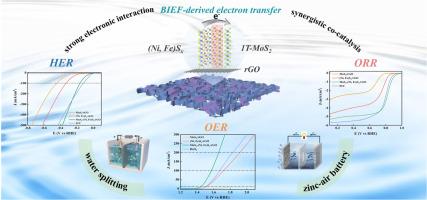Regulating intermediates adsorption/desorption behavior in multilayered 2D MoS2-(Ni, Fe)Sx/rGO heterostructure via built-in electric field-driven electron transfer for water splitting and zinc-air battery
IF 14.3
1区 材料科学
Q1 MATERIALS SCIENCE, MULTIDISCIPLINARY
引用次数: 0
Abstract
Deliberate construction of 2D/2D heterostructure with interfacial built-in electric field (BIEF) is a reliable strategy to address sluggish reaction kinetics through electronic structure optimization and reaction microenvironment modulation. Herein, a novel multilayered MoS2-(Ni, Fe)Sx/rGO hierarchical hybrid was synthesized via interfacial BIEF and dimensional engineering, featuring metallic-phase MoS2 (1T-MoS2) nanosheets and (Ni, Fe)Sx nanoflakes vertically anchored on rGO. This 2D/2D heterostructure allows large interface contact area via interfacial S-bridge spatial confinement, which provides abundant transport pathways for BIEF-derived large electron transfer from (Ni, Fe)Sx to 1T-MoS2, thus favoring rapid reaction kinetics. Benefiting from the strong interfacial electron coupling and synergistic co-catalytic effects, the as-obtained MoS2-(Ni, Fe)Sx/rGO displays extraordinary multifunctional catalytic activity, as confirmed in extremely low overpotentials at 10 mA cm−2 for HER (38 mV) and OER (213 mV), along with a positive half-wave potential for ORR (0.82 V), thus delivering excellent efficiency and stability in water splitting and zinc-air batteries. Combining theoretical calculations and the in-situ characterizations, the reconfiguration of electronic structure and appropriate d-band center, driven by asymmetrical charge distributions arising from the interface-induced BIEF, endows key intermediates with balanced adsorption/desorption capability, thereby enhancing intrinsic catalytic activity and reducing reaction energy barriers.

通过内置电场驱动电子转移调节多层二维MoS2-(Ni, Fe)Sx/rGO异质结构中中间体吸附/解吸行为,用于水裂解和锌-空气电池
通过优化电子结构和调节反应微环境,有意构建带有界面内置电场(BIEF)的2D/2D异质结构是解决反应动力学迟缓问题的可靠策略。本文通过界面BIEF和尺寸工程,合成了一种新型多层MoS2-(Ni, Fe)Sx/rGO层叠结构,其金属相MoS2 (1T-MoS2)纳米片和(Ni, Fe)Sx纳米片垂直锚定在rGO上。这种2D/2D异质结构通过界面s桥空间限制允许较大的界面接触面积,为bief衍生的大电子从(Ni, Fe)Sx转移到1T-MoS2提供了丰富的传输途径,从而有利于快速反应动力学。得益于强大的界面电子耦合和协同催化效应,所获得的MoS2-(Ni, Fe)Sx/rGO表现出非凡的多功能催化活性,证实了在10 mA cm−2下HER (38 mV)和OER (213 mV)的极低过电位,以及ORR (0.82 V)的正半波电位,从而在水分解和锌-空气电池中提供了出色的效率和稳定性。结合理论计算和原位表征,界面诱导BIEF产生的不对称电荷分布驱动下的电子结构重构和合适的d带中心,赋予关键中间体平衡的吸附/解吸能力,从而提高本征催化活性,降低反应能垒。
本文章由计算机程序翻译,如有差异,请以英文原文为准。
求助全文
约1分钟内获得全文
求助全文
来源期刊

Journal of Materials Science & Technology
工程技术-材料科学:综合
CiteScore
20.00
自引率
11.00%
发文量
995
审稿时长
13 days
期刊介绍:
Journal of Materials Science & Technology strives to promote global collaboration in the field of materials science and technology. It primarily publishes original research papers, invited review articles, letters, research notes, and summaries of scientific achievements. The journal covers a wide range of materials science and technology topics, including metallic materials, inorganic nonmetallic materials, and composite materials.
 求助内容:
求助内容: 应助结果提醒方式:
应助结果提醒方式:


